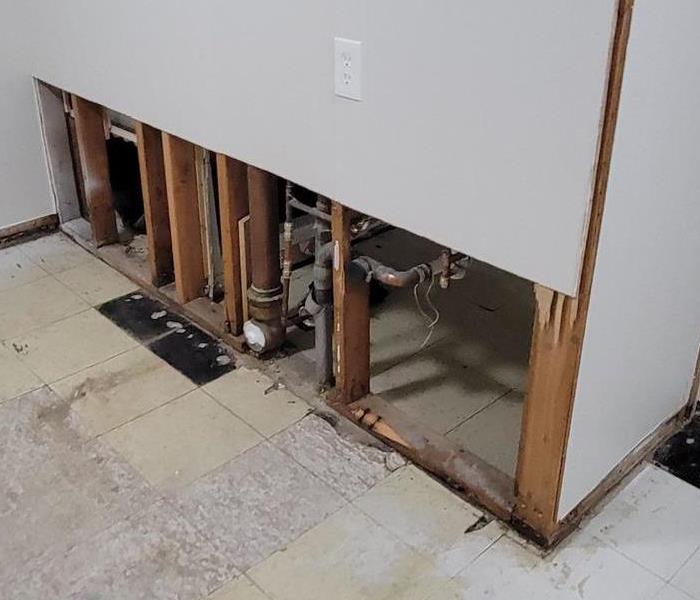Recent Posts
How Fire Damage Impacts Your Electrical Systems and Appliances
12/19/2024 (Permalink)
Fire damage can have far-reaching consequences, especially when it comes to the electrical systems and appliances within your home. Electrical damage following a fire is not always immediately visible but can pose serious safety risks if not addressed properly. Understanding how fire affects your home’s wiring, appliances, and overall electrical system is crucial for ensuring the safety of your property and preventing further damage or accidents. Here’s a closer look at the impact of fire on electrical systems and appliances, and what you should do in the aftermath.
1. Impact of Heat and Flames on Electrical Wiring
Fire can severely damage electrical wiring throughout your home, even if the flames do not come into direct contact with the wires. The intense heat generated by a fire can melt or warp plastic insulation around wires, exposing the metal conductors. This increases the risk of short circuits, electrical shocks, and further fire hazards. Damaged wiring can also lead to power surges, which may cause appliances to malfunction or overheat. In extreme cases, hidden wiring damage can go unnoticed and lead to electrical fires long after the initial incident.
2. Smoke and Soot Contamination
Even in cases where the fire was contained to one area, smoke and soot can travel throughout the home, contaminating your electrical system. Soot is a carbon-based substance that can easily penetrate electrical outlets, switchboards, and circuit breakers. Once inside, soot can cause electrical components to short-circuit, corrode, or fail altogether. The acidic nature of soot can also corrode metal contacts, wiring, and sensitive electronics, causing long-term damage.
If your home has been affected by smoke, it’s important to have a professional inspect your electrical system for contamination and clean or replace any affected components to prevent future issues.
3. Damage to Appliances
Fire can severely affect the functionality and safety of household appliances. Large appliances such as refrigerators, ovens, and washing machines may have suffered damage from heat, soot, or water used to extinguish the fire. Water damage, in particular, can ruin electrical components, rendering appliances unsafe to use. Even if an appliance appears intact, hidden damage to wiring or internal circuits can cause it to malfunction or pose a fire risk when powered back on.
Smaller appliances, such as microwaves, toasters, and coffee makers, may also be affected by heat, smoke, or water exposure. It’s important to have these items inspected by a professional to determine if they are salvageable or need to be replaced.
4. Professional Inspection and Restoration
After a fire, it is crucial to have a certified electrician inspect your home’s entire electrical system before turning the power back on. A thorough assessment will determine the extent of the damage, identify any compromised wiring, and ensure that your system is safe to use. Depending on the severity of the damage, some or all of the electrical components may need to be replaced.
Additionally, electrical appliances that have been exposed to fire, smoke, or water should be professionally tested before use. Restoration professionals, like those at SERVPRO of Johnston County South, are experienced in assessing fire-damaged properties, including electrical systems and appliances. They can help you determine which appliances are salvageable and provide the necessary repairs or replacements.
Understanding the potential risks fire poses to your electrical system and appliances is essential for preventing further damage and ensuring your home’s safety. Electrical issues resulting from fire are not always immediately visible, which is why it’s critical to have professional inspections and repairs done. Whether dealing with damaged wiring or soot-contaminated appliances, SERVPRO of Johnston County South is here to help you restore your home and ensure it’s safe for you and your family to return.
Mold and Water Damage Restoration: A Comprehensive Approach to Protecting Your Property
11/7/2024 (Permalink)
Water damage and mold growth are often closely linked, as moisture creates the ideal conditions for mold to thrive. When water damage occurs in a home or commercial building, it’s essential to address both the water damage and the potential for mold growth to ensure a complete restoration. Ignoring one aspect can lead to lingering problems that affect the structure of the property and create additional issues down the line.
In this blog, we'll explore the comprehensive approach needed for effective mold and water damage restoration and how professional services, such as those offered by SERVPRO®, can ensure that your property is fully restored.
Understanding the Link Between Water Damage and Mold
When water infiltrates a building due to leaks, flooding, or other causes, it creates the perfect environment for mold to grow. Mold spores are present in the air, but they require moisture to develop into visible mold colonies. Within 24 to 48 hours of water exposure, mold can begin to grow on wet surfaces, including walls, floors, ceilings, and furniture.
This is why water damage restoration must go hand in hand with mold remediation. If water damage is not properly addressed, mold growth can become a serious problem, potentially leading to structural damage.
Steps in Comprehensive Water Damage and Mold Restoration
Effective water damage and mold restoration requires a multi-step approach to ensure all affected areas are thoroughly treated. Here’s how SERVPRO handles the process:
Initial Assessment and Inspection
The first step in any water damage and mold restoration project is a thorough assessment. SERVPRO technicians inspect the property to identify all areas affected by water damage, including hidden moisture that may not be immediately visible. They also assess areas at risk of mold growth or where mold has already begun to form.
By using specialized tools such as moisture meters and infrared cameras, professionals can detect water damage and mold in hard-to-reach areas like behind walls, under floors, or in ceilings. This comprehensive inspection ensures that no affected area goes untreated.
Water Extraction
After the assessment, the next step is water extraction. This process involves removing any standing water from the property using industrial-grade pumps and vacuums. The faster the water is removed, the less chance there is for mold to grow. SERVPRO's advanced equipment ensures that all excess water is quickly and efficiently removed from the premises.
Drying and Dehumidification
Once the water is extracted, drying and dehumidification are crucial to prevent further damage and mold growth. SERVPRO uses air movers, dehumidifiers, and drying equipment to remove moisture from surfaces and the air. This process can take several days, depending on the extent of the water damage.
During this phase, SERVPRO monitors the drying process to ensure that all moisture levels return to normal. Special attention is given to porous materials like drywall, wood, and carpet, which can retain moisture and become a breeding ground for mold.
Mold Containment and Remediation
If mold is present, the next step is containment and remediation. Mold spores can spread easily through the air, so it’s important to contain the affected area to prevent further contamination. SERVPRO uses containment methods like plastic sheeting and negative air pressure to keep mold spores from spreading to unaffected areas of the property.
After containment, the mold remediation process begins. This involves physically removing mold from surfaces, cleaning or replacing contaminated materials, and using air filtration systems to remove mold spores from the air.
Cleaning and Sanitization
Once the water damage and mold remediation processes are complete, the entire affected area must be thoroughly cleaned and sanitized. SERVPRO uses specialized cleaning agents and antimicrobial treatments to eliminate any remaining traces of mold and bacteria.
This step also involves cleaning personal belongings, furniture, and other items affected by water damage. Carpets, upholstery, and fabrics may need to be professionally cleaned or replaced, depending on the extent of the damage.
Restoration and Repairs
The final step in the comprehensive restoration process is repairing and restoring the property. This can involve minor repairs, such as replacing drywall or painting, or more extensive work, like rebuilding entire sections of the property. SERVPRO ensures that the property is returned to its pre-water damage condition, restoring both the appearance and structural integrity.
Preventing Future Water Damage and Mold Growth
While the immediate water damage and mold issues can be resolved, prevention is key to avoiding future problems. After the restoration process, SERVPRO provides recommendations for preventing water damage and mold growth in the future. Whether the water damage was caused by a leaky roof, broken pipe, or flooding, it’s crucial to repair the source to prevent further damage. Regularly inspecting your home or business for signs of water damage or mold growth can help catch problems early before they become significant issues.
Why Professional Services Matter
While some water damage or mold issues may seem minor, they can quickly escalate if not handled properly. Professional water damage restoration and mold remediation services like those provided by SERVPRO ensure that all aspects of the problem are thoroughly addressed, preventing long-term damage and restoring your property to its original condition. By using advanced equipment, trained technicians, and a comprehensive approach, SERVPRO can efficiently and effectively manage both water damage and mold remediation, saving you time, money, and stress.
Water damage and mold are closely intertwined, and a comprehensive approach is necessary to address both issues. Whether dealing with a burst pipe, flooding, or hidden leaks, it's essential to have professionals like SERVPRO of Johnston County South to handle the situation to ensure that your property is fully restored.
Emergency Kits: Must-Have Items for Water Damage Situations
10/16/2024 (Permalink)
 At SERVPRO, we’re here to assist you with comprehensive water damage restoration services.
At SERVPRO, we’re here to assist you with comprehensive water damage restoration services.
When water damage strikes, having an emergency kit ready can make all the difference in how quickly and efficiently you can respond to the situation. At SERVPRO®, we understand the urgency that comes with water damage, and we recommend preparing a kit with essential items to help you manage the initial impact of water intrusion.
Essential Items for Immediate Response
One of the first things you'll need in a water damage emergency is a set of tools to help you minimize the damage while waiting for professional assistance. A sturdy, waterproof flashlight with extra batteries is essential, especially if the power goes out or if you need to navigate through dark, waterlogged areas. Additionally, a basic tool kit with items like a utility knife, adjustable wrench, and screwdrivers can help you quickly shut off water valves, remove soaked materials, or perform other necessary tasks.
Waterproof gloves and boots should also be included in your kit. These will protect your hands and feet from exposure to contaminated water and allow you to safely move through affected areas. Heavy-duty trash bags are another must-have, as they can be used to quickly gather and dispose of water-damaged items.
Protecting Important Documents and Valuables
In the chaos of a water damage event, it’s easy to overlook the importance of securing valuable documents and belongings. Your emergency kit should include waterproof containers or bags for storing important documents like insurance papers, identification, and property records. Having these items protected will not only preserve their integrity but also make the recovery process smoother when you’re ready to file insurance claims or assess the extent of the damage.
If you have irreplaceable valuables such as family heirlooms, photographs, or small electronics, consider adding protective cases or waterproof storage solutions to your kit. This extra step can save you from losing items of sentimental or monetary value.
Supplies for Temporary Repairs
While waiting for SERVPRO to arrive, it’s important to take steps to prevent further water damage. Your emergency kit should include materials for temporary repairs, such as tarps, duct tape, and plastic sheeting. These items can be used to cover leaks, windows, or any openings where water might be entering your home. Sandbags can also be useful for blocking water from entering through doors or low-lying areas.
Another key item is a portable wet/dry vacuum. This tool can help you remove standing water from small areas, preventing it from spreading and causing additional damage. Be sure to follow safety guidelines when using electrical equipment in wet conditions.
Being prepared with an emergency kit tailored for water damage situations can help you respond quickly and effectively when disaster strikes. By having the right tools, protective gear, and supplies on hand, you can take immediate action to mitigate damage and protect your property until professional help arrives. At SERVPRO, we’re here to assist you with comprehensive water damage restoration services, but a well-prepared emergency kit is your first line of defense.
How to Create a Home Inventory for Storm Insurance Claims: A Step-by-Step Guide
9/10/2024 (Permalink)
When a storm strikes, the damage to your home can be overwhelming. Having a detailed home inventory can make the process of filing insurance claims significantly smoother and faster. This step-by-step guide will help you create a comprehensive home inventory, ensuring you're prepared to document your losses accurately and efficiently in the event of a storm.
Step 1: Gather Your Supplies
- Notebook or Spreadsheet: Choose a method that works best for you, whether it’s a physical notebook, a digital spreadsheet, or an inventory app.
- Camera or Smartphone: You'll need this to take photos or videos of your belongings.
- Receipts and Documentation: Collect any receipts, warranties, and documentation for your valuable items.
Step 2: Start Room by Room
- Systematic Approach: Go through your home room by room, starting with one corner and working your way around the room to ensure nothing is missed.
- Document Everything: Record all items, including furniture, electronics, appliances, clothing, and decor. Don’t forget items stored in closets, drawers, and cabinets.
Step 3: Describe Each Item
- Detailed Descriptions: For each item, write a detailed description including the make, model, serial number, and any other identifying features.
- Condition and Age: Note the condition and age of the item, as this can affect its value.
Step 4: Take Photos and Videos
- Photographic Evidence: Take clear, well-lit photos of each item, including close-ups of serial numbers and unique features.
- Video Walkthrough: Consider doing a video walkthrough of your home, narrating as you go to describe each item and its condition.
Step 5: Document Purchase Details
- Receipts and Warranties: Attach receipts, warranties, and appraisals to your inventory list. If you don’t have receipts, note the approximate date and place of purchase.
- Value Estimation: Estimate the current value of each item, especially for high-value items like jewelry and electronics.
Step 6: Store Inventory Safely
- Multiple Copies: Keep multiple copies of your inventory, both physical and digital. Store a copy in a safe place like a fireproof safe, and another off-site or in the cloud.
- Update Regularly: Regularly update your inventory to account for new purchases, gifts, or items you’ve discarded.
Step 7: Use Inventory Apps
- Digital Tools: Consider using home inventory apps that can help streamline the process and provide templates for easy documentation.
- Cloud Storage: Many apps offer cloud storage, ensuring your inventory is accessible and safe even if your home is damaged.
Step 8: Consult Your Insurance Provider
- Understand Your Policy: Review your insurance policy to understand coverage limits and requirements for documentation.
- Ask for Guidance: Contact your insurance provider for any specific guidelines they may have for home inventories and claims.
Step 9: Conduct an Annual Review
- Regular Updates: Set a reminder to review and update your inventory annually or whenever you make significant purchases.
- Verify Coverage: Check with your insurance provider to ensure your coverage is adequate based on the current value of your belongings.
Creating a home inventory is a crucial step in preparing for storm-related insurance claims. By documenting your belongings thoroughly, you can ensure a smoother claims process and help secure the compensation you deserve. Take the time to follow this step-by-step guide, and you’ll be better prepared to protect your home and its contents in the event of a storm.
Seeing Beyond the Surface: The Benefits of Thermal Imaging in Fire Damage Restoration
8/13/2024 (Permalink)
Fire damage restoration is a complex process that requires thorough assessment and precise remediation techniques. Traditional methods of inspection may not always reveal hidden damage lurking beneath the surface. However, with the advent of thermal imaging technology, restoration professionals have a powerful tool at their disposal. In this blog, we'll explore the benefits of using thermal imaging in fire damage restoration and highlight how SERVPRO® utilizes this technology to deliver superior results.
Understanding Thermal Imaging
Thermal imaging, also known as infrared thermography, is a non-invasive technique that captures heat signatures emitted by objects and surfaces. This technology detects temperature variations and displays them as color-coded images, allowing restoration professionals to identify hidden moisture, heat sources, and structural anomalies.
Benefits of Thermal Imaging in Fire Damage Restoration
Moisture is a common issue in fire-damaged properties, as firefighting efforts can leave behind excess water that may seep into building materials. Thermal imaging allows restoration technicians to detect moisture pockets behind walls, under flooring, and within ceilings, enabling targeted drying and mitigation efforts. Traditional visual inspections may overlook areas of concern that are not immediately visible to the naked eye. Thermal imaging provides a comprehensive view of the property, revealing hidden damage and potential fire hazards that require attention.
By pinpointing areas of moisture intrusion and heat retention, thermal imaging enables restoration professionals to develop a precise remediation plan tailored to the specific needs of the property. This targeted approach streamlines the restoration process, reducing downtime and minimizing disruption to occupants. Thermal imaging can be used not only for post-fire damage assessment but also for preventive maintenance inspections. By regularly monitoring temperature variations and moisture levels, property owners can identify potential issues early on and address them before they escalate into major problems.
SERVPRO's Expertise in Thermal Imaging
SERVPRO invests in advanced thermal imaging technology to enhance the accuracy and efficiency of fire damage restoration projects. Their technicians are trained to interpret thermal images and use them to guide remediation efforts effectively. We conduct thorough inspections of fire-damaged properties using thermal imaging technology to identify hidden damage and develop a customized restoration plan. Armed with thermal imaging data, our technicians can target moisture and heat sources with precision, ensuring thorough remediation and preventing future issues.
Thermal imaging technology has revolutionized the fire damage restoration industry, providing restoration professionals with invaluable insights into the condition of fire-damaged properties. By leveraging thermal imaging technology, SERVPRO delivers comprehensive and efficient restoration services, restoring properties to their pre-fire condition quickly and effectively. Don't settle for surface-level assessments—trust SERVPRO of Johnston City South for their expertise in thermal imaging for superior fire damage restoration results.
Do Mold-Resistant Paints and Coatings Really Work?
7/15/2024 (Permalink)
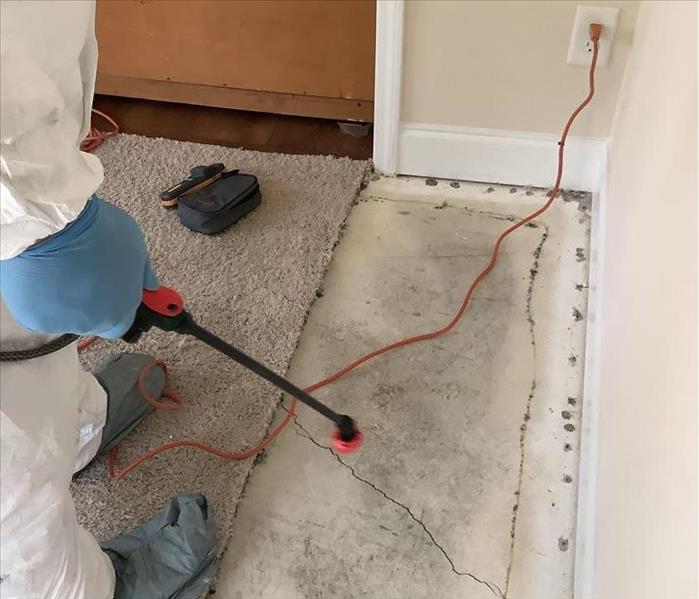 At SERVPRO of Johnston County South, we’re here to help you keep your home in top shape, no matter the challenge.
At SERVPRO of Johnston County South, we’re here to help you keep your home in top shape, no matter the challenge.
When tackling mold in your home, prevention is key, and one popular method is using mold-resistant paints and coatings. But do these products really work as advertised? In this blog, we’ll dive into what mold-resistant paint is, how it works, and whether it's a reliable option for keeping your walls mold-free.
What is Mold-Resistant Paint?
Mold-resistant paint is designed to inhibit the growth of mold on painted surfaces. It contains antimicrobial agents that mitigate mold spores from taking root and spreading. This type of paint is especially useful in areas of your home that tend to be damp or have high humidity levels, such as bathrooms, kitchens, and basements.
How Does Mold-Resistant Paint Work?
The key to the effectiveness of mold-resistant paint lies in its formulation. These paints are infused with compounds that actively discourage mold growth. When applied to walls and other surfaces, they create an environment that is less hospitable to mold. The antimicrobial agents in the paint disrupt mold spores’ ability to grow and multiply, helping to keep the coated surfaces cleaner and free of mold.
The Benefits of Using Mold-Resistant Paint
- Reduced Mold Growth: The most obvious benefit is its ability to mitigate mold growth, which helps maintain the structural integrity of your walls and reduces the need for frequent repaints due to mold damage.
- Ideal for High-Moisture Areas: For rooms that are prone to dampness, such as your bathroom or laundry room, mold-resistant paint can be a game-changer, providing an extra layer of protection against moisture-induced damage.
- Ease of Use: Just like any regular paint, mold-resistant paint is easy to apply, requiring no special techniques or tools. It’s a convenient option for both DIY enthusiasts and professional painters.
Limitations of Mold-Resistant Paint
While mold-resistant paint can be effective, it’s not a foolproof solution. Here are some limitations to consider:
- Not a Standalone Solution: It's important to manage expectations. Mold-resistant paint helps limit mold growth but doesn't address existing mold. If your home already has a mold issue, it's necessary to remove the mold before applying the paint.
- Environmental Requirements: The effectiveness can also depend on the environment. In extremely damp conditions, even the best mold-resistant paint may struggle to keep mold at bay without additional moisture control measures.
- Durability: Over time, the effectiveness of the antimicrobial agents can diminish. In areas with persistent moisture problems, you may need to reapply mold-resistant paint periodically to maintain its mold-preventing properties.
Is Mold-Resistant Paint Right for You?
Choosing whether to use mold-resistant paint depends on your specific needs and the condition of your home. If you live in a humid climate or have rooms with poor ventilation, incorporating mold-resistant paint could be a wise addition to your home maintenance strategy. However, it's best used as part of a broader approach to moisture and mold control, which includes proper ventilation and regular inspections of potential problem areas.
Mold-resistant paints and coatings can be a tool used to help prevent mold growth in your home. They work effectively under the right conditions and when used correctly. However, remember that they are part of a larger mold prevention strategy. Regular upkeep and addressing moisture issues are crucial for keeping your home healthy and mold-free.
If you’re considering mold-resistant paint for your home and need more advice on the best products or application methods, don’t hesitate to reach out to a professional. At SERVPRO of Johnston County South, we’re here to help you keep your home in top shape, no matter the challenge.
Frozen Pipes and Water Damage: Prevention and Recovery
6/12/2024 (Permalink)
 In this blog, we will discuss steps you can take to prevent frozen pipes and how to recover from water damage caused by frozen pipes.
In this blog, we will discuss steps you can take to prevent frozen pipes and how to recover from water damage caused by frozen pipes.
Winter brings with it the risk of frozen pipes, which can lead to water damage if not addressed promptly. When water inside pipes freezes, it expands and puts pressure on the pipe walls, causing them to burst. Burst pipes can result in significant water damage to your home or business. In this blog, we will discuss steps you can take to prevent frozen pipes and how to recover from water damage caused by frozen pipes.
Prevention: Insulate and Protect Your Pipes
Preventing frozen pipes starts with proper insulation. Here are some steps to protect your pipes from freezing:
- Insulate Exposed Pipes: Insulate any exposed pipes in unheated areas of your home or business, such as basements, attics, crawlspaces, and garages. You can use foam pipe insulation sleeves or heat tape to provide a protective layer.
- Seal Cracks and Leaks: Inspect your property for any cracks or leaks in walls, floors, or foundations. Seal them with caulk or weather-stripping to prevent cold air from entering and affecting the pipes.
- Keep Interior Temperature Consistent: Maintain a consistent temperature throughout your property, especially during freezing temperatures. Set your thermostat to a minimum of 55 degrees Fahrenheit, even when you are away.
- Open Cabinet Doors: If you have pipes inside cabinets, especially those located near exterior walls, open the cabinet doors to allow warm air to circulate and reach the pipes.
Recovery: What to Do if Pipes Freeze and Burst
Despite your best preventative efforts, frozen pipes can still occur. If you experience frozen pipes and subsequent water damage, here's what you should do:
- Shut off Water Supply: As soon as you discover a burst pipe, locate the main water shut-off valve in your property and turn it off. This will prevent further water flow and minimize damage.
- Call SERVPRO® for Professional Water Remediation: Frozen pipes can cause extensive water damage, including damage to walls, floors, and belongings. Contact SERVPRO professionals who specialize in water damage restoration. They have the expertise and equipment to extract water, dry affected areas, and restore your property to its preloss condition.
- Document the Damage: Take photos or videos of the water damage and make a detailed list of affected items. This documentation will be helpful for insurance claims and the restoration process.
- Remove Excess Water: If it is safe to do so, remove any standing water to prevent further damage. You can use mops, towels, or a wet/dry vacuum.
- Do Not Forget About Mold Prevention: Even after the water is extracted and the affected areas are dried, there is still a risk of mold growth. SERVPRO professionals use specialized techniques to ensure proper drying and take preventive measures against mold.
In conclusion, preventing frozen pipes and addressing water damage promptly are vital during the winter months. By insulating and protecting your pipes and knowing what to do in the event of frozen pipes and subsequent water damage, you can minimize the impact on your home or business. Remember, if you experience water damage from frozen pipes, contact SERVPRO for professional water remediation services. Our experts will help you recover and restore your property efficiently and effectively.
Post-Storm Safety: Identifying and Avoiding Hazards
5/15/2024 (Permalink)
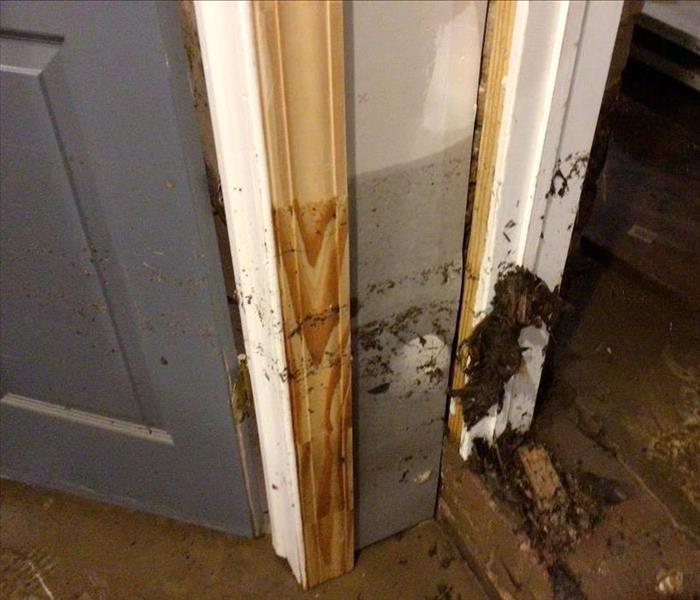 In this blog post, we will explore important safety tips for post-storm situations.
In this blog post, we will explore important safety tips for post-storm situations.
After a severe storm, it's essential to prioritize safety as you assess the damage to your property and begin the cleanup process. Storm damage can create various hazards that could cause further injuries or property damage if not properly identified and avoided. In this blog post, we will explore important safety tips for post-storm situations and how to identify and avoid hazards during the aftermath of a storm emergency.
1. Stay Informed and Follow Local Authority Guidelines
Listen to local authorities and stay informed about any safety guidelines or evacuation orders in your area. They will provide important information regarding potential hazards and safe practices following a storm.
2. Assess Structural Damage
Before entering your property after a storm, thoroughly assess its structural integrity for any signs of damage. Look for sagging roofs, leaning walls, or weakened foundations that could pose a risk of collapse. If you suspect structural damage, evacuate immediately and contact professionals to evaluate the situation.
3. Watch Out for Fallen Power Lines
Stay away from any fallen power lines in your surroundings, as they may still be live and pose a severe electrocution hazard. Report fallen power lines to your local utility provider and maintain a safe distance until they resolve the situation.
4. Beware of Standing Water
After a storm, be cautious of standing water, as it may be electrified or contain hazardous substances. Avoid direct contact with standing water, and never attempt to wade or drive through it. Standing water can hide debris, sharp objects, and open utility holes.
5. Be Mindful of Gas Leaks
If you smell gas or suspect a gas leak, evacuate your property immediately. Avoid turning on or off any electrical switches, as a spark could ignite the gas. Contact your gas company or emergency services and wait for a professional to evaluate and resolve the situation.
6. Take Precautions During Cleanup
When starting the cleanup process, wear appropriate protective gear, such as gloves, boots, and a mask, to prevent injuries and exposure to harmful substances. Use caution while handling debris, as it may contain sharp objects or hazardous materials.
7. Use Caution with Generators
If you are using a generator for temporary power, ensure it is located outside your home in a well-ventilated area. Generators produce carbon monoxide (CO) gas, which is odorless and can be deadly. Avoid using generators in enclosed spaces, including garages or basements.
8. Be Aware of Chemical Spills
Check for any chemical spills that may have occurred during the storm. If you identify any hazardous materials, follow appropriate protocols for containment and cleanup, wearing protective equipment as necessary. Contact local authorities or professional cleanup services for assistance.
9. Avoid Damaged Trees and Branches
Inspect trees on your property for signs of damage or instability. Damaged trees and branches may still be at risk of falling, especially during high winds or subsequent storms. Stay clear of these hazards and seek professional assistance to handle large or hazardous trees.
10. Document the Damage
Document the storm damage to your property through photographs or videos. This documentation will be helpful for insurance claims and can assist cleanup and restoration professionals in understanding the extent of the damage when you contact them.
In conclusion, being aware of post-storm safety and identifying potential hazards are crucial steps in your storm damage plan. By following these safety tips and taking precautions when assessing and cleaning up after a storm, you can protect yourself, your property, and your loved ones from further harm. Remember, SERVPRO® professionals are available to assist with storm damage cleanup and restoration to help you recover as quickly and safely as possible. Stay safe, stay informed, and prioritize safety during the aftermath of a storm emergency.
Understanding the Differences in Fire Damage Restoration Techniques
4/17/2024 (Permalink)
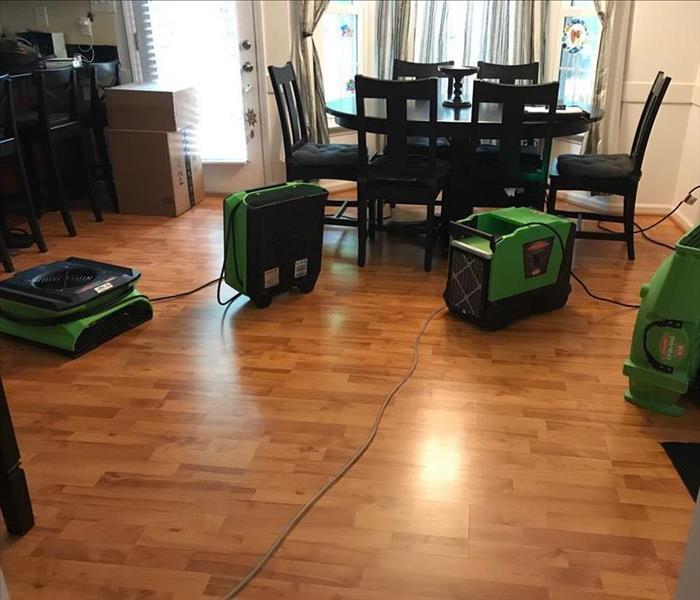 In this blog, we will explore the various fire damage restoration techniques employed by experts to effectively mitigate fire damage.
In this blog, we will explore the various fire damage restoration techniques employed by experts to effectively mitigate fire damage.
When a fire strikes, it can leave behind devastating damage that requires professional fire damage cleanup and restoration. Understanding the different techniques used in fire damage restoration is crucial for restoring your property and belongings to their pre-fire condition. In this blog, we will explore the various fire damage restoration techniques employed by experts to effectively mitigate fire damage and restore the affected areas.
Assessment and Safety Measures
The first step in fire damage restoration is a comprehensive assessment of the impacted areas. Professionals inspect the extent of the fire damage, identify structural issues, and assess the presence of smoke and soot residues. They also prioritize safety by ensuring the affected areas are structurally stable and free from any hazards before initiating the restoration process.
Board-Up and Roof Tarping
If the fire has compromised windows, doors, or the roof, professionals secure your property by board-up and roof tarping. This mitigates further damage caused by exterior elements like weather and trespassers. Board-up and roof tarping also offer protection during the fire damage cleanup and restoration process.
Water Extraction and Drying
Firefighters often use substantial amounts of water to extinguish fires, leading to additional damage from water and moisture. The fire damage cleanup process involves water extraction to remove excess moisture. Specialized drying techniques, such as the use of dehumidifiers and air movers, ensure thorough drying of the affected areas and mitigate the risk of secondary damage like mold growth.
Soot and Smoke Residue Removal
Soot and smoke residues can easily spread throughout the property, affecting surfaces, furniture, and belongings. Fire damage restoration professionals use specialized techniques to clean and remove soot and smoke residues. This may involve dry cleaning methods, wet cleaning techniques, or chemical sponges to restore different surfaces effectively.
Odor Elimination
One of the challenges of fire damage restoration is eliminating the persistent odor left behind by smoke and soot. Professionals employ various techniques such as thermal fogging, ozone treatments, or air scrubbers to neutralize and eliminate odors. This ensures that your property is free from lingering smoke smells once the restoration process is complete.
Structural Reconstruction
In cases of severe fire damage, structural reconstruction may be necessary. Fire damage restoration experts work closely with contractors and construction teams to ensure the safe and effective reconstruction of damaged areas. This involves rebuilding walls, replacing flooring, and restoring the structural integrity of the property.
Content Cleaning and Restoration
Fires can damage not only the structure but also your personal belongings. Professional fire damage cleanup includes content cleaning and restoration, where professionals carefully assess, clean, and restore salvageable contents. This may involve specialized cleaning techniques for delicate items, electronic restoration, or document recovery.
Fire damage restoration is a complex and multi-faceted process that requires the expertise of professionals. From initial assessment to content cleaning and structural reconstruction, fire damage restoration technicians employ a range of techniques to ensure your property is restored to its pre-fire condition. If you experience a fire incident, contact fire remediation experts like SERVPRO® who can promptly respond, assess the damage, and provide efficient fire damage cleanup and smoke damage restoration services. Their expertise and advanced techniques will help mitigate further damage and guide you through the restoration process, bringing your property back to its original state.
Mold and Fire Damage Restoration: A Combined Approach
3/13/2024 (Permalink)
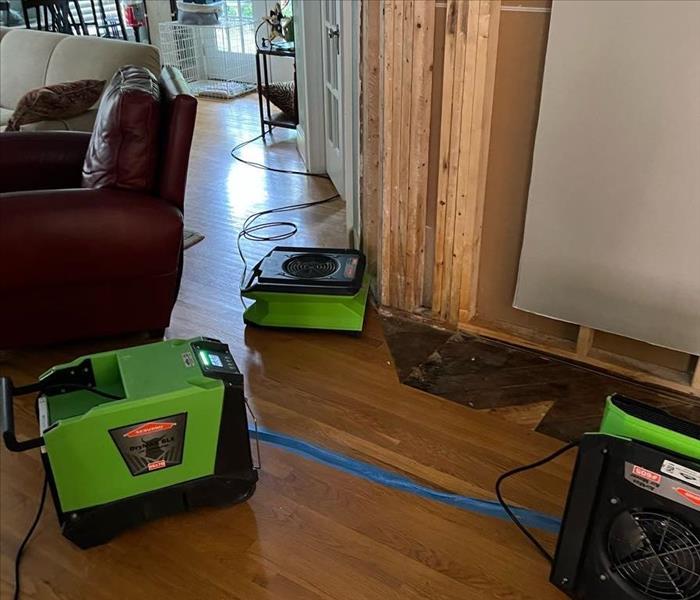 In this blog, we will explore the importance of a combined approach to mold and fire damage restoration.
In this blog, we will explore the importance of a combined approach to mold and fire damage restoration.
Property damage caused by both mold and fire can be devastating for homeowners and business owners. In certain cases, properties can be affected by both mold damage and fire damage simultaneously. Restoration efforts require a combined approach to address the unique challenges presented by mold and fire damage. In this blog, we will explore the importance of a combined approach to mold and fire damage restoration.
Understanding Mold and Fire Damage
Mold damage occurs when excess moisture and humidity create a suitable environment for mold to grow and thrive. Mold can spread rapidly, causing discoloration, odor, and structural damage to the affected areas. On the other hand, fire damage occurs due to flames, heat, and smoke. Fires can leave behind charred materials, structural damage, and residual smoke odor.
Challenges of Mold and Fire Restoration
Mold and fire restoration services require a comprehensive and specialized approach. Combining these two restoration processes can present unique challenges. Some of the key challenges include:
- Coordinating Efforts: Combining mold and fire damage restoration efforts requires coordination between different restoration professionals. It is essential that all aspects of the damage are addressed effectively and efficiently.
- Addressing Hidden Damage: Mold and fire damage can sometimes be concealed within the walls, ceilings, or other structural elements. It is important to conduct thorough inspections to identify hidden damage and ensure its proper remediation.
The Combined Mold and Fire Restoration Process
Here is how the combined process of mold remediation and fire restoration works at SERVPRO®:
- Assessment: The first step in the restoration process is a thorough assessment of the property. Trained professionals will evaluate the extent of both mold and fire damage and develop a comprehensive restoration plan.
- Containment: To prevent the spread of mold spores and fire residues, containment measures are implemented. This may involve setting up physical barriers, using negative air pressure systems, and implementing proper ventilation.
- Removal of Damaged Materials: All materials affected by mold or fire damage are safely removed, including charred materials, soot, and mold-infested materials. Proper disposal procedures are followed to prevent cross-contamination.
- Cleaning and Sanitization: The affected areas are cleaned and sanitized using specialized equipment and techniques to ensure the removal of all mold spores and fire residues. This step is crucial in preventing future mold growth and eliminating any remaining smoke odors.
- Drying and Restoration: After thorough cleaning, the property is dried and restored. This may involve replacing damaged drywall, insulation, flooring, and other structural elements.
- Preventive Measures: Additional preventive measures may be recommended to protect the property from future mold and fire damage. This can include implementing proper ventilation systems, increasing insulation, and ensuring moisture control.
Importance of Professional Restoration Services
For effective mold and fire damage restoration, it is crucial to seek professional assistance. Experienced restoration professionals have the knowledge, training, and specialized equipment to handle both aspects of the damage. They will ensure that all safety protocols are followed, hidden damage is identified and addressed, and the property is restored to its pre-damage condition.
Restoring a property after mold and fire damage requires a combined approach that addresses the unique challenges of both types of damage. A comprehensive assessment, containment, removal of damaged materials, thorough cleaning, and restoration efforts are crucial to successful restoration. Seeking professional restoration services ensures that the restoration process is carried out efficiently and effectively, resulting in a safe and restored property.

 24/7 Emergency Service
24/7 Emergency Service

